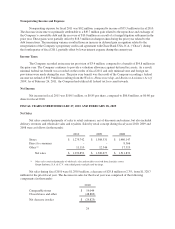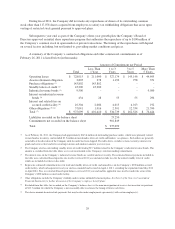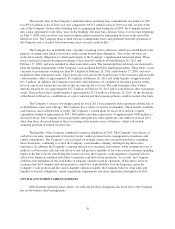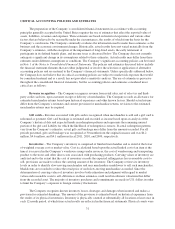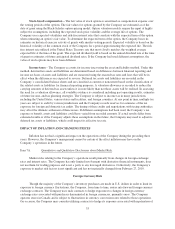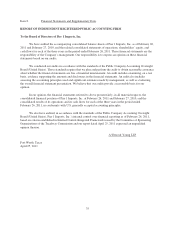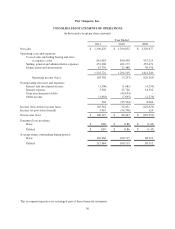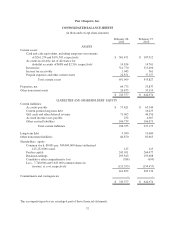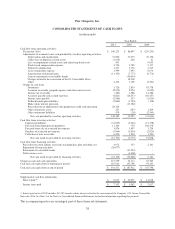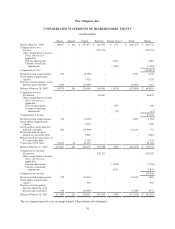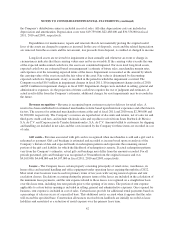Pier 1 2011 Annual Report Download - page 39
Download and view the complete annual report
Please find page 39 of the 2011 Pier 1 annual report below. You can navigate through the pages in the report by either clicking on the pages listed below, or by using the keyword search tool below to find specific information within the annual report.
Stock-based compensation – The fair value of stock options is amortized as compensation expense over
the vesting periods of the options. The fair values for options granted by the Company are estimated as of the
date of grant using the Black-Scholes option-pricing model. Option valuation models require the input of highly
subjective assumptions, including the expected stock price volatility and the average life of options. The
Company uses expected volatilities and risk-free interest rates that correlate with the expected term of the option
when estimating an option’s fair value. To determine the expected term of the option, the Company bases its
estimates on historical exercise activity of grants with similar vesting periods. Expected volatility is based on the
historical volatility of the common stock of the Company for a period approximating the expected life. The risk
free interest rate utilized is the United States Treasury rate that most closely matches the weighted average
expected life at the time of the grant. The expected dividend yield is based on the annual dividend rate at the time
of grant or estimates of future anticipated dividend rates. If the Company had used different assumptions, the
value of stock options may have been different.
Income taxes – The Company accounts for income taxes using the asset and liability method. Under this
method, deferred tax assets and liabilities are determined based on differences between financial reporting and
income tax bases of assets and liabilities and are measured using the enacted tax rates and laws that will be in
effect when the differences are expected to reverse. Deferred tax assets and liabilities are recorded in the
Company’s consolidated balance sheets and are classified as current or noncurrent based on the classification of
the related assets or liabilities for financial reporting purposes. A valuation allowance is recorded to reduce the
carrying amounts of deferred tax assets unless it is more likely than not those assets will be realized. In assessing
the need for a valuation allowance, all available evidence is considered including past operating results, estimates
of future income, and tax planning strategies. The Company is subject to income tax in many jurisdictions,
including the United States, various states and localities, and foreign countries. At any point in time, multiple tax
years are subject to audit by various jurisdictions and the Company records reserves for estimates of the tax
exposure for foreign and domestic tax audits. The timing of these audits and negotiations with taxing authorities
may affect the ultimate settlement of these issues. If different assumptions had been used, the Company’s tax
expense or benefit, assets and liabilities could have varied from recorded amounts. If actual results differ from
estimated results or if the Company adjusts these assumptions in the future, the Company may need to adjust its
deferred tax assets or liabilities, which could impact its effective tax rate.
IMPACT OF INFLATION AND CHANGING PRICES
Inflation has not had a significant impact on the operations of the Company during the preceding three
years. However, the Company’s management cannot be certain of the effect inflation may have on the
Company’s operations in the future.
Item 7A. Quantitative and Qualitative Disclosures about Market Risk.
Market risks relating to the Company’s operations result primarily from changes in foreign exchange
rates and interest rates. The Company has only limited involvement with derivative financial instruments, does
not use them for trading purposes and is not a party to any leveraged derivatives. Collectively, the Company’s
exposure to market risk factors is not significant and has not materially changed from February 27, 2010.
Foreign Currency Risk
Though the majority of the Company’s inventory purchases are made in U.S. dollars in order to limit its
exposure to foreign currency fluctuations, the Company, from time to time, enters into forward foreign currency
exchange contracts. The Company uses such contracts to hedge exposures to changes in foreign currency
exchange rates associated with purchases denominated in foreign currencies, primarily euros. The Company
operates stores in Canada and is subject to fluctuations in currency conversion rates related to those operations.
On occasion, the Company may consider utilizing contracts to hedge its exposure associated with repatriation of
33



